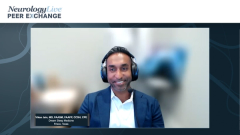
Considering Sleep Studies for Insomnia
A brief review of the value of polysomnography, or sleep studies, in diagnosing patients with insomnia.
Episodes in this series

Transcript:
Michael J. Thorpy, MD:We all agree that history is the most important part of assisting a patient with insomnia. But there are times we need to consider doing sleep studies. Vikas, when might you consider getting a sleep study on a patient who has insomnia?
Vikas Jain, MD, FAASM, FAAFP, CCSH, CPE:I look at a few things. When I’m getting history, 1 is trying to get some sense of, are they having a lot of sleep disruption? Are they complaining of a lot of awakenings that seem to be occurring during the night? Could they be complaining of excessive limb movements? Or “I kick around a lot. I’m a restless sleeper.” That might make me think more about periodic limb movement disease and if they’re a snorer in addition to these awakenings. I might consider looking for sleep-related breathing disorders. I also like to consider doing sleep testing, more in patients who’ve had a long-standing history of insomnia that hasn’t seemed to respond to traditional interventions with our pharmacological interventions. There was a study several years ago in Mayo Clinic proceedings that showed a high prevalence of sleep disorder breathing in many patients who’ve gone for a long period of time with chronic insomnia. Thus, it can be helpful sometimes when you’ve tried several interventions and you say, “What else could there be?” That can be helpful to elicit if there’s an underlying cause for it.
Michael J. Thorpy, MD:How also would you pick up sleep apnea in a patient who may have insomnia? Are there any particular patients where that’s more likely to occur?
Vikas Jain, MD, FAASM, FAAFP, CCSH, CPE:I would say it’s a lot more likely than 1 would think. I’ve found that there tends to be a fairly high prevalence, at least in the patients that I’ve seen with refractory insomnia that have some degree of sleep disorder breathing present that no one has thought to look for because this person is complaining, “I can’t get to sleep” or “I can’t stay asleep.” No one is thinking that to go hunting for sleep-disordered breathing or sleep apnea.
Nathaniel Fletcher Watson, MD: It may be that these patients don’t check all the boxes. They’re not an older, obese male who’s snoring and sleepy. What I’m getting at is this upper-airway resistance syndrome, which might be a female who’s younger and thinner, and nobody is telling them they’re snoring. They have some fatigue and sleep disturbance, so it can be difficult at times. But those might be the type of individuals for whom you’d end up identifying sleep-disordered breathing, in which you thought you were dealing with a primary insomnia problem. Of course, in the context of this discussion, it’s important to note that that insomnia alone is not an indication for polysomnography. Vikas makes great points. When we see other signs that there might be something else going on, then we can move down that pathway. But in the patient who comes in and doesn’t have any real other risk factors or issues, we’re going to be steering away from it.
Karl Doghramji, MD: It’s very important to keep a high index of suspicion for sleep apnea in the context of insomnia, especially in psychiatric disease. We know that the presence of apnea can mean underlying psychiatric disturbances. For example, patients with post-traumatic stress disorder [PTSD] who have sleep apnea have a much worse time with PTSD than patients who do not. Getting rid of their sleep apnea often helps PTSD symptoms. These are patients who often present with a chief complaint of insomnia.
Erinn E. Beagin, MD: Does it help if I ask the patient? Because this is 1 of the screening questionnaires for an internist to get a home sleep study: if they’re falling asleep easily during the day. Does that help with any distinction of if I asked you lie down and take a nap, would that patient with obstructive sleep apnea be the 1 who conks out immediately and maybe a primary or an insomnia patient being more likely to say, “You could give me 20 minutes and I’d still be staring at you.”
Vikas Jain, MD, FAASM, FAAFP, CCSH, CPE: I would say insomniacs who may have sleep disorder breathing generally aren’t scoring very high on their Epworth Sleepiness Scale. That’s a scale of 0 24. How likely are you to fall asleep in different situations? Most people are going to say, “I can never fall asleep because I’m an insomniac.” Sometimes people say, “That person is Epworth 0 or 2 or 4. If they’re not sleepy, why would I look for a sleep-related breathing disorder?” Sometimes that can fool you, so it’s greatly important not to only look at that.
Michael J. Thorpy, MD:Certainly, we need to differentiate those patients who are falling asleep during the day, whose primary complaint is insomnia. I see patients with narcolepsy, and their primary complaint is difficulty sleeping, but when you question them more, you find that they’re sleepy during the day. As you mentioned, for many patients with insomnia, it’s a 24-hour-a-day problem. They can’t sleep at night. They can’t sleep during the day. For those who do sleep during the day, we need to pay special attention to them to see if there’s some other underlying condition.
Transcript edited for clarity.
Newsletter
Keep your finger on the pulse of neurology—subscribe to NeurologyLive for expert interviews, new data, and breakthrough treatment updates.

























